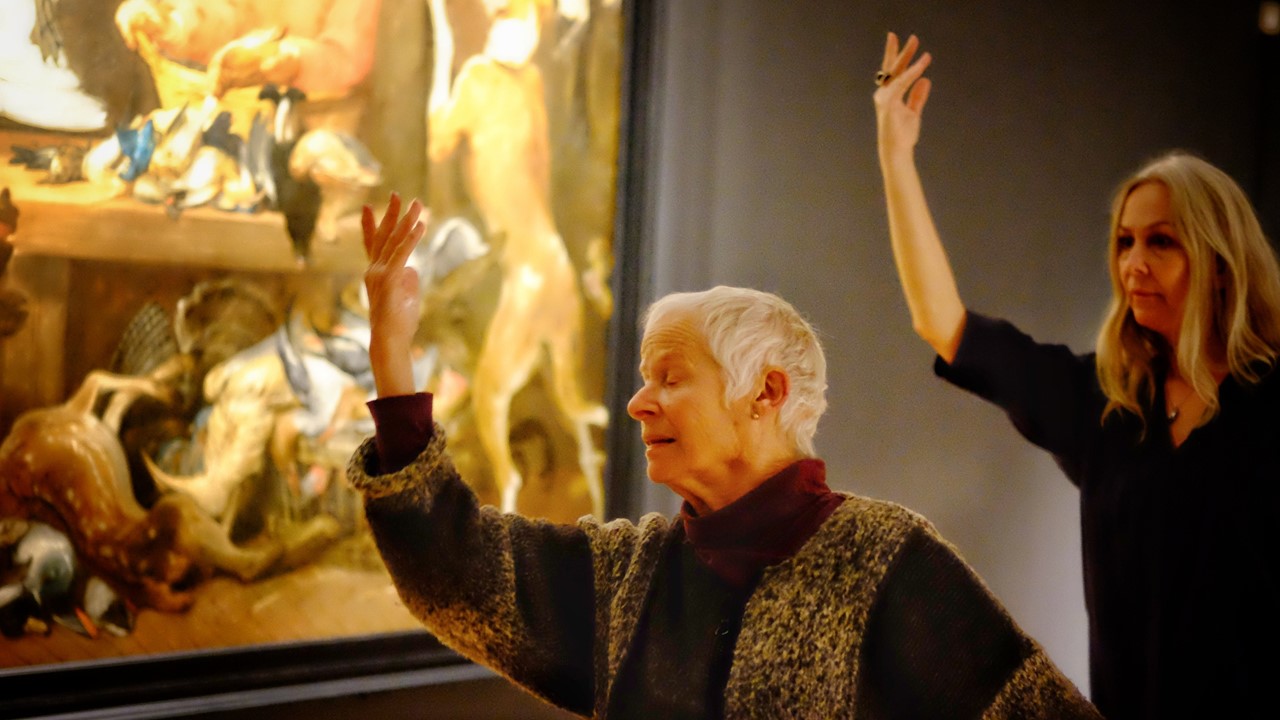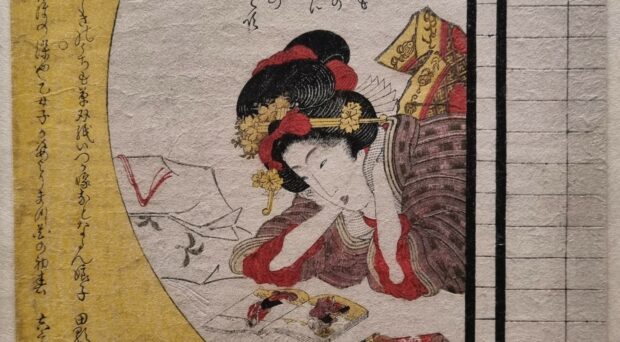Relax, look and imagine is the invitation made in seven films launched this week that explore artworks from the Fitzwilliam Museum‘s collection. The films take us on a journey in which we soften and settle, step into an artwork, drink in the detail, the artistry and its qualities and take the time to feel how it resonates with us.
Drawing on the established practice of the Dance with the Museum programme, co-created with sheltered housing residents across the city of Cambridge, each of the films is a seventeen-minute opportunity to form a personal relationship with art.
The films have been made by Toby Peters and narrated by the Dance with the Museum programme artist Filipa Pereira-Stubbs.
So, why have these films been made?
Human endeavor, creativity, curiosity and imagination underpin much of the magic held within museums and their collections; with artworks and artefacts having the power to transport, inspire and absorb us.
A core question for us in this time of lockdown has been, if we can’t access the ‘real’ thing, if we can’t let people into museums and set the scene for experiences to be had; who are we, what is our purpose and what can we achieve? And then – critically informing our answers to this, how do we ensure that we don’t simply ‘fill the access void’ with poor imitations, but rather continue in that spirit of endeavour, creativity, curiosity and imagination?
All this being said … what does this look like ‘on the ground’ or ‘at the kitchen table’? Asking ourselves and our community partners these questions, the Dance and Time with the Museum team have been feeling their way through to a few answers, some of which are now ready to be shared.

A quick recap on the programme to set the scene: inspired by and led in collaboration with dance artist Filipa Pereira-Stubbs, Dance and Time with the Museum began in 2016 as a partnership between the University of Cambridge Museums and colleagues and residents from the Cambridge City Council Sheltered Housing Schemes and Independent Living Service. Working and learning together, we found having shared journeys through artworks where we relax, look slowly, move our bodies in self-expression and share our learning makes us feel good. As a founder participant says this is
‘Such a release, I’ve got so much inside that wants to come out…it makes real sense of the Museum, it’s no longer a place of static statues.’
The process of co-creation and positive feedback gave us the confidence to seek and secure additional funds in 2019 from the National Lottery Community Fund. With this we have been able to expand the programme to a spectrum of settings, with partners across the County: five more sheltered housing settings, Arthur Rank Hospice, Addenbrooke’s Hospital, two residential care settings and two day-centres.
Each partner, each setting, each participant share with each other a real enthusiasm for this opportunity to come together through art, to explore and express what it means to live and be alive. This is where the similarity can be seen to stop, with each of the participants having different lived experiences, living conditions, cultural backgrounds and indeed values, beliefs and attitudes. The practice of exploring art together has this diversity at its core – setting the scene for each of us to enjoy finding our own way into and interpreting art.

So how have we responded so far to this matrix of: participants and partners, our new shared spaces, our joy in journeying through art and our continued commitment to endeavor, create and imagine?
Stepping into new territory with old friends
Objects in Focus
As lockdown was announced, the team chose 24 collection images to use as the basis for ‘some sort’ of remote offer. The criteria for this choice was simple – beauty! Forget everything else, what was felt to be the priority was the opportunity to escape and be immersed in works that felt magical, safe and gentle. 200 high resolution copies of each were made, 200 envelopes purloined, and 200 stamps ordered. This set of 24 artworks have become the programme’s Objects in Focus, framing the different strands of engagement (listed below) planned for April – August 2020.
Consultation, collaboration and co-production
Once safely at home and settled at ‘kitchen tables’ the team began a careful process of understanding the experiences, needs and opportunities of the partner organisations and participants: what resource did people have, what challenges were they facing, what were the emotional qualities of their experience and how could or might they connect with the programme.
One example of the process of consultation and collaboration was with the sheltered housing and day centre participants. Here, through a series of one-to-one phone calls, we agreed upon and then refined an approach together that was open to all. The calls revealed that most people were on their own in flats, anxious and bored and quickly running out of (phone) conversation with friends and family; very few had access to or familiarity with digital devices, but all did have a phone! Regular, short, small group hosted conference calls emerged as an option that looked good enough to try, with the post backing this up through the distribution of the Object in Focus artworks to people’s homes and regular correspondence to confirm session details.
Another example of working together, going forward, has been with our Care Home, Hospital and Hospice partnerships which are being held through on-going dialogue and the development of or adaption of resources and activity in response to this. Anxiety is frequently being identified as a real challenge for both residents, service users and patients and for the staff who care for them. The notion of creating video content, that could be accessed when people were able, that captured the relaxation, immersive slow looking process and invitations to escape and imagine, was seen by all as something that would be of great benefit. These are the films launched here. Sitting along side these are a series of Object in Focus posters and postcards, designed for people who are best reached either through the post and or at the bedside in a care setting.
Putting the programme together
At the time of writing this blog, seven weeks on from lockdown and an indeterminate number of weeks ahead of us, the programme activity has four interlinked, co-produced activity strands. These are:
1: Relax, Look, Imagine: films & guides
For each of the artworks the team are creating a written guide that can be used by a facilitator in a health or residential care setting (along with copies of the artworks, sent by post) to support groups and individuals ‘journey through’ the paintings. The guide begins with relaxation, moves into slow looking, then to imagining and ends with a short biography of the artist, description of their practice and insights into the artwork.
These guides are forming the basis of the scripts for the films (launched in this blog) with programme artist Filipa Pereira-Stubbs narrating and filmmaker Toby Peters providing gorgeous spring imagery from his garden to set the scene and then gentle tracking shots of the artwork as we go through the process of slow looking.
The films and guides have been created in response to the needs and parameters of our health and residential care setting partners including Addenbrooke’s Hospital. Seven have been made so far, and we hope to continue creating more. They will also allow for engagement to extend to new settings and with new partners, specifically those who maybe experiencing stress and anxiety as a result of loneliness and isolation – during lockdown and beyond.
A final note – although originally created to mirror practice developed with a particular group of participants in the Museum, we do very much hope that everyone and anyone will be able to enjoy the films!
2: Time together at home: telephone conference calls
Small group sessions reaching approximately 80 residents from the Independent Living Service (ILS) and members of our two-day center partnerships. From April – July this year we plan to meet twice a month and together take time to relax and go on a shared journey through one artwork each time. Packs of the artworks have been sent to people’s homes and the conference calls are being managed by the Phone Co-op. Each session is being facilitated by one team member with an additional member listening in and being on hand if needed. The ILS and day centers both act as the reporting point for any safeguarding concerns i.e. if team members feel concerned about a participant.
3: Artwork in focus: postcards & posters
A light touch and flexible opportunity to engage with each artwork designed for use in health and residential care settings. Each artwork is accompanied by three invitations: to be curious, notice, and imagine. A link to the accompanying film is included with an invitation to spend more time with the artwork.
4: Artwork in focus: art activity and postcard exchange packs
So far these packs have been specifically for our care home partners; containing reproduction artworks, the looking guides, art materials, art activity ideas and postcards. The packs have been providing activity coordinators and carers with the tools to look, imagine and then make. Additionally, the team have set up a process of correspondence with residents, whereby postcards with handwritten narratives about the artworks (sent by post) are setting up a process of exchange and dialogue. Weekly email correspondence with the homes is supporting the process. Currently the team are exploring how this approach could be extended to other settings.
What next?
As with the rest of the world we are working on this one! Feedback so far has been universally positive, but we are aware that these are early days. There is so much that can be done, but it’s important that we continue to plan, respond and progress in the spirit of considered care that in so many ways are the hallmarks of museums and galleries. For instance we haven’t as yet been able to do video conferencing as this is inaccessible to many and we haven’t been able to take people fully into dance, the core of this work; we have both in our sights and are hopeful that we will be able to make steps very soon …
This is the first of our blog series about this rich area of work. Next month, Alison Ayres, who along with Sarah Villis are the programme co-originators, will share her growing insights into and experience of the Time together at home telephone conference calls, of which she is a facilitator and anchor person. We look forward to sharing more then.
You can view the full series of seven videos on the University of Cambridge Museums YouTube channel.







